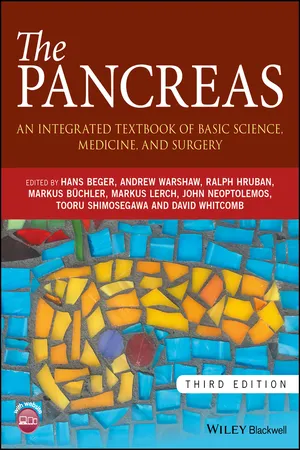
The Pancreas
An Integrated Textbook of Basic Science, Medicine, and Surgery
- English
- ePUB (mobile friendly)
- Available on iOS & Android
The Pancreas
An Integrated Textbook of Basic Science, Medicine, and Surgery
About this book
This brand new updated edition of the most comprehensive reference book on pancreatic disease details the very latest knowledge on genetics and molecular biological background in terms of anatomy, physiology, pathology, and pathophysiology for all known disorders. Included for the first time, are two brand new sections on the key areas of Autoimmune Pancreatitis and Benign Cystic Neoplasms. In addition, this edition is filled with over 500 high-quality illustrations, line drawings, and radiographs that provide a step-by-step approach to all endoscopic techniques and surgical procedures. Each of these images can be downloaded via an online image bank for use in scientific presentations.
Every existing chapter in The Pancreas: An Integrated Textbook of Basic Science, Medicine and Surgery, 3rd Edition has been thoroughly revised and updated to include the many changes in clinical practice since publication of the current edition. The book includes new guidelines for non-surgical and surgical treatment; new molecular biologic pathways to support clinical decision making in targeted treatment of pancreatic cancer; new minimally invasive surgical approaches for pancreatic diseases; and the latest knowledge of neuroendocrine tumors and periampullary tumors.
- The most encyclopedic book on the pancreas—providing outstanding and clear guidance for the practicing clinician
- Covers every known pancreatic disorder in detail including its anatomy, physiology, pathology, pathophysiology, diagnosis, and management
- Completely updated with brand new chapters
- Over 500 downloadable illustrations
- An editor and author team of high international repute who present global best-practice
The Pancreas: An Integrated Textbook of Basic Science, Medicine and Surgery, 3rd Edition is an important book for gastroenterologists and gastrointestinal surgeons worldwide.
Frequently asked questions
- Essential is ideal for learners and professionals who enjoy exploring a wide range of subjects. Access the Essential Library with 800,000+ trusted titles and best-sellers across business, personal growth, and the humanities. Includes unlimited reading time and Standard Read Aloud voice.
- Complete: Perfect for advanced learners and researchers needing full, unrestricted access. Unlock 1.4M+ books across hundreds of subjects, including academic and specialized titles. The Complete Plan also includes advanced features like Premium Read Aloud and Research Assistant.
Please note we cannot support devices running on iOS 13 and Android 7 or earlier. Learn more about using the app.
Information
Section 1
Anatomy of the Pancreas
1
Development of the Pancreas and Related Structures
Anatomy of the Pancreas
Organogenesis in the Region of the Pancreas

Early Pancreatic Development
Table of contents
- Cover
- Title Page
- Table of Contents
- Contributors
- Preface
- Abbreviations
- About the Companion Website
- Section 1: Anatomy of the Pancreas
- Section 2: Physiology and Pathophysiology of Pancreatic Functions
- Section 3: Acute Pancreatitis
- Section 4: Chronic Pancreatitis
- Section 5: Autoimmune Pancreatitis
- Section 6: Neoplastic Tumors of the Exocrine Tissue: Benign Cystic Neoplasms of the Pancreas
- Section 7: Neoplastic Tumors of Exocrine Tissue: Pancreatic Cancer
- Section 8: Neoplastic Tumors of the Endocrine Pancreas
- Section 9: Periampullary Cancers and Tumors Other Than Pancreatic Cancer
- Section 10: Transplantation of the Pancreas
- Index
- End User License Agreement